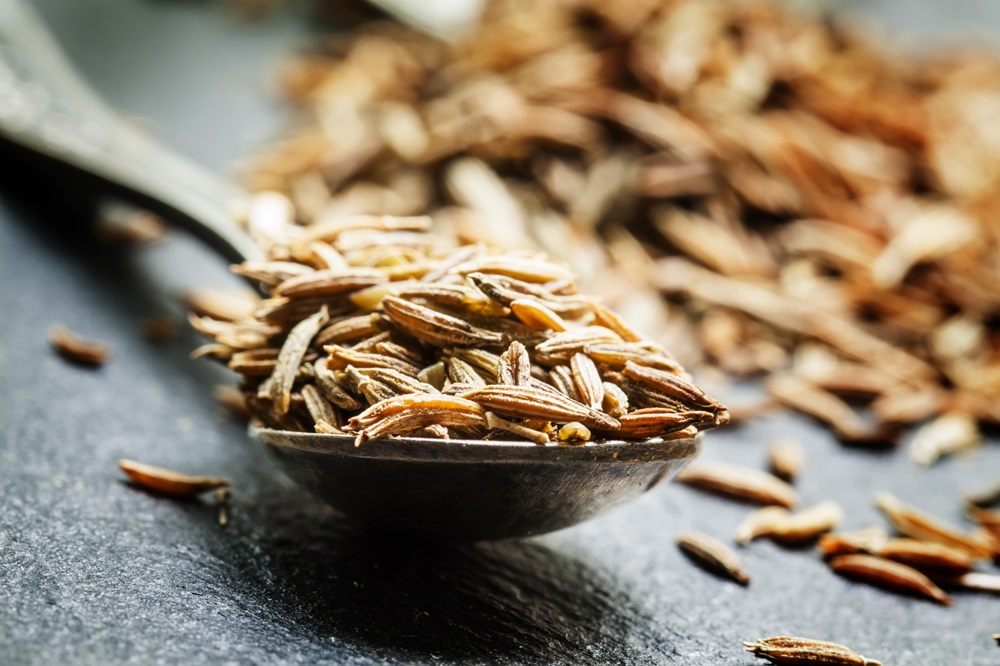Cumin – Properties, Uses, Contraindications

Cumin is a plant whose seeds are known for their aromatic flavor and intense fragrance. This spice is widely used in preparing oriental dishes and may have a positive effect on the human body - cumin can, for example, support weight loss and show antibacterial activity. What are cumin’s nutritional values? How can it be used? What properties does cumin have?
Table of contents
- Cumin - what is it?
- Cumin vs. caraway
- Cumin - nutritional values
- Cumin - properties. How does it work?
- Cumin - how to use it?
- Cumin - contraindications
- Cumin - side effects
Cumin - what is it?
Cumin (Cuminum cyminum L.), also known as Roman cumin or Egyptian cumin, is an annual plant belonging to the Apiaceae family. This spice originates from Southwest Asia but can also be found in Central Asian countries, Egypt, and in the eastern Mediterranean region. It is now widely cultivated, with India being the largest modern producer.
Cumin grows thin, rounded, and highly branched stems that can reach about 50 cm in height. From these stems sprout large, very thin leaves made up of thread-like segments. In summer, large umbrella-shaped flower clusters appear at the tops of the stems, in red or white. After flowering, they develop into fruit clusters containing paired schizocarps that separate into two mericarps.
Cumin is a heat-loving herb that prefers fertile, moderately moist soil. It is a demanding and difficult-to-cultivate plant, primarily used as a spice, characterized by an intense, slightly sharp taste.
Cumin vs. caraway
Cumin is often confused with common caraway – while they belong to the same botanical family, they differ in appearance, growing requirements, and flavor.
Cumin is an annual plant that is now rarely found in the wild. It is a cultivated herb that is not frost-resistant. Caraway, on the other hand, is a biennial plant that naturally grows in Europe as well as parts of Asia and Africa.
Cumin seeds are larger and lighter in color than caraway seeds. The plants also differ greatly in taste and aroma – cumin has an intense, tangy-sharp flavor, while caraway is characterized by a warm, slightly bitter taste. Cumin’s aroma is earthy, whereas caraway has a slightly sweet fragrance.
Cumin - nutritional values
Cumin contains significant amounts of valuable macronutrients. In 100 g of the plant, there are nearly 45 g of carbohydrates, 22 g of fats, and 18 g of protein. Additionally, cumin contains dietary fiber as well as vitamins and minerals – notable micronutrients include calcium, iron, magnesium, phosphorus, potassium, and B vitamins such as B1, B2, and B6, as well as vitamins A, C, and E.
Cumin is also considered a source of bioactive compounds. It contains polyphenols, such as quercetin, gallic acid, and p-coumaric acid. Additionally, cumin contains essential oils like cuminaldehyde, safranal, and cymene, which are mainly responsible for its characteristic aroma.
It is worth noting, however, that cumin is used in daily cooking only in small amounts as a seasoning. Therefore, even though the spice is rich in valuable compounds, it delivers only trace amounts of these substances to the human body.
Cumin - properties. How does it work?
In folk medicine, cumin has been used for hundreds of years as support for various ailments. It has been attributed with anti-inflammatory, diuretic, antimicrobial properties, as well as stimulating digestive juices and improving digestion. While not all of these traditional uses are confirmed by modern research, there are many studies indicating cumin’s potential health benefits.
Research to date suggests that cumin may help improve the blood lipid profile. Consuming cumin, whether as ground seeds, essential oil, or extract, may reduce total cholesterol levels in the blood and lower LDL (“bad” cholesterol). Some publications also suggest that cumin may be beneficial for people with type 2 diabetes – it can help lower fasting blood glucose, reduce triglycerides, and increase HDL (“good” cholesterol).
Some studies indicate that cumin may relieve certain symptoms of irritable bowel syndrome (IBS). Data suggest that cumin extract can reduce abdominal pain and bloating and may support regular bowel movements. The plant may also have bacteriostatic and bactericidal properties, as well as antiviral effects, helping fight infections, particularly those caused by Staphylococcus aureus.
Additionally, cumin may support weight loss. Research suggests it can reduce BMI and waist circumference, making it a valuable ingredient in a weight-reduction diet.
Cumin - how to use it?
Cumin is a spice plant widely used in cuisines around the world as an aromatic seasoning. Its intense, slightly sharp taste works well in meat dishes such as stews, lamb, or poultry, and it is often added to marinades and pickled products. Cumin is also popular in soups, bread, and potato dishes, and sometimes in rice or cheese recipes. Moreover, it is used in making liqueurs and tinctures, as well as in dishes like hummus and chili con carne.
Cumin pairs well with spices such as cinnamon, cardamom, ginger, cloves, and nutmeg. It is also a common ingredient in spice blends like curry and garam masala.
Since ground cumin is intense and aromatic, even small amounts can strongly influence the taste and aroma of dishes.
Cumin - contraindications
Cumin is generally considered a safe spice that should not cause adverse effects and is well tolerated by the human body.
However, because cumin can interact with certain medications, people taking antibiotics, anti-inflammatory drugs, or antidiabetic medicines should exercise caution. Those on anticonvulsant drugs should also be careful, as cumin may interfere with their effectiveness.
Cumin - side effects
Occasional use of cumin in moderate amounts should not cause any side effects. However, in people consuming large amounts over a long period, there may be an increased risk of bleeding, respiratory complications, or, in some cases, skin inflammation.

